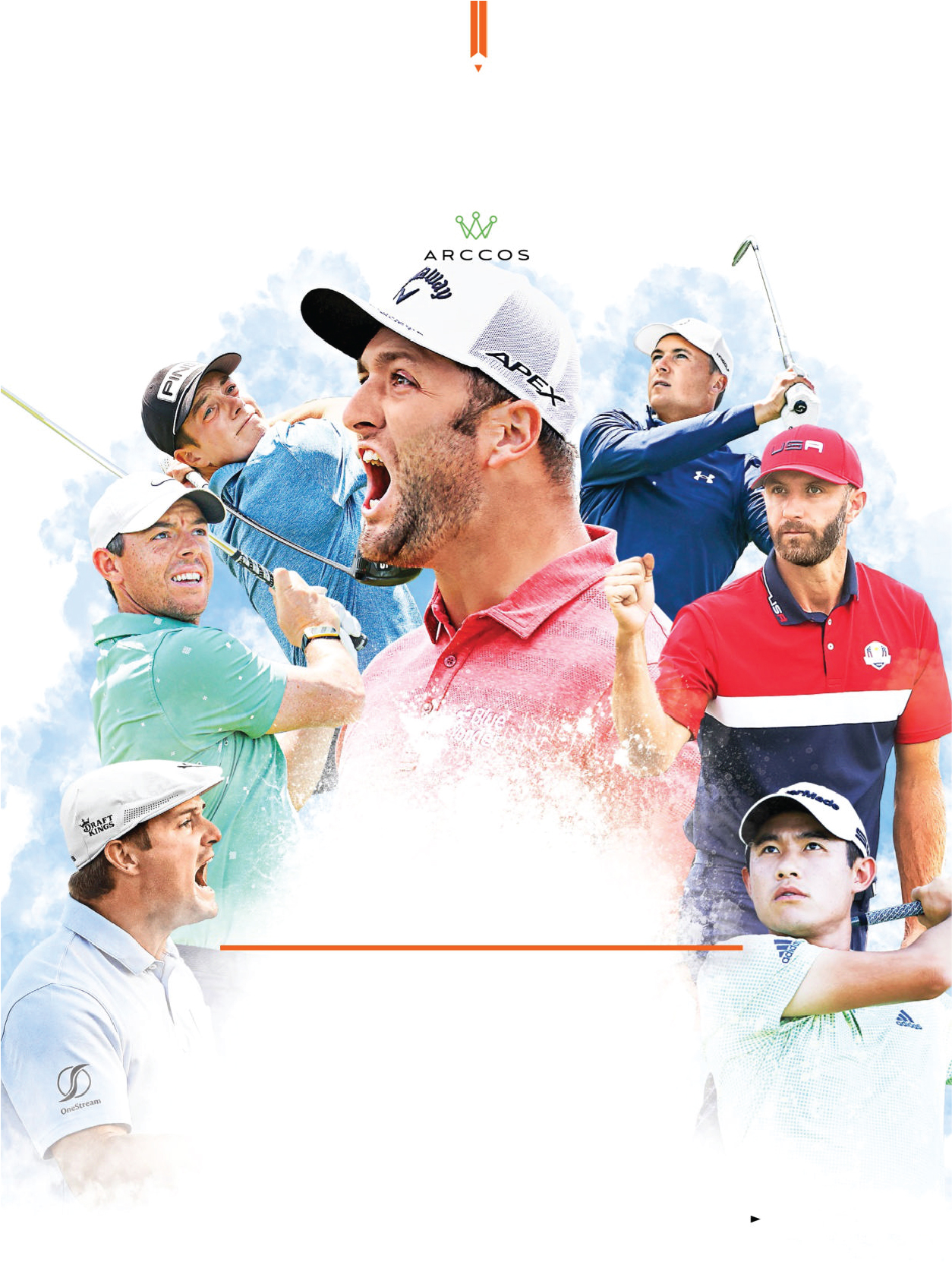There are a number of reasons why we sit down on a Sunday evening to watch the world’s best players. First of all, there’s no better sight than witnessing Rory McIlroy in total control of his game, Jordan Spieth putt his rivals into submission or even Bryson DeChabeau trying to muscle his way to victory. However, these players offer more than just entertainment.
Every week, the likes of Jon Rahm and
co provide free tips – we just have to
watch and learn. Of course, sometimes
those swing slo-mos get a little bit
technical, and what works for someone
like Dustin Johnson might not work for
the average club golfer.
So, we asked Top 25 Coach Gary Alliss to analyse seven of the world’s finest players. What is it exactly that makes them so successful? And what can you learn? Whether you need to hit a longer ball or hole more putts, over the next six pages you’re sure to find some useful
nuggets to help you shoot lower scores.
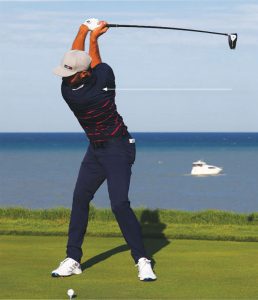
DJ & Bryson
dr iving distance
- The power that these two players generate comes from their physical size, combined with an incredible ability to turn their upper body an enormous distance while resisting with their hips – which hardly turn at all.
This is how they produce such huge clubhead speed.
The shoulder turn is so impressive they’re able to turn as far as possible
and resist a little with the lower body.
Ask most club golfers to do this and they end up lifting the left heel way off the ground, which defeats the object.
You need that little bit of resistance.
DeChambeau has obviously bulked up, but with both players what I really like is their stance width. With that big base, you can really drive off the back foot, through the hips to the lead foot, which is a massive factor in generating clubhead speed. It’s that saying: power in golf comes from the feet.
So, to get more distance, you might want to try widening your stance perhaps an inch with the trail foot to start with. Another good exercise is to take a practice swing and at the top of your backswing, make an effort to look right back over your trail shoulder (behind you). This will help you to transfer your weight a little bit more behind the ball.
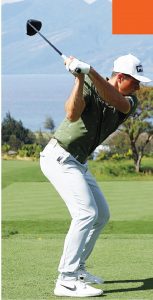
Viktor Hovland
dr iving accuracy
2. The power that these two players generate comes from their physical size, combined with an incredible ability to turn their upper body an enormous distance while resisting with their hips – which hardly turn at all.
This is how they produce such huge clubhead speed.
The shoulder turn is so impressive they’re able to turn as far as possible
and resist a little with the lower body.
Ask most club golfers to do this and they end up lifting the left heel way off the ground, which defeats the object.
You need that little bit of resistance.
DeChambeau has obviously bulked up, but with both players what I really like is their stance width. With that big base, you can really drive off the back foot, through the hips to the lead foot, which is a massive factor in generating clubhead speed. It’s that saying: power in golf comes from the feet.
So, to get more distance, you might want to try widening your stance perhaps an inch with the trail foot to start with. Another good exercise is to take a practice swing and at the top of your backswing, make an effort to look right back over your trail shoulder (behind you). This will help you to transfer your weight a little bit more behind the ball.
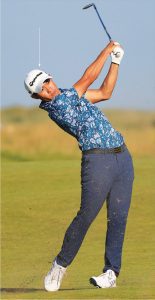
Viktor Hovland –
dr iving accuracy
3. The Norwegian is not only pretty accurate with the
big stick, but he’s fairly long, too. The key to his
accuracy is the position he gets the club in at the top
of the backswing. His right elbow points vertically down to
the ground and sits close to his torso. As a consequence, it
causes his left wrist to bow over slightly, which in turn
marginally closes the face (it looks towards the sky).
It’s a position that could cause hooks, but he starts the
clearing of his left side quickly, and he pulls forcefully with
his left arm. As a result, his left forearm leads into impact,
which ensures the clubface can’t return to a closed position.
With the left arm leading, the hips clearing fast and the
clubhead path travelling quite quickly to the left of a
straight line to the target, he’s able to hit a very powerful
drive – and one that tends to move from left to right.
This can be difficult for amateurs to emulate. However, if
you have a tendency to hook the ball, try setting up on the
right side of the tee box. Pick a spot 200 yards down the
left edge of the fairway, aim at this target and just open
the clubface a fraction. Your body alignment should be a
little open to this aim line (not parallel left). Swing normally
and try to hit your aim point. With practice, you should
groove a nice, safe fade.
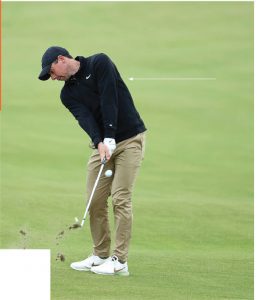
Collin
Mor ikawa –
i ron play
3. Morikawa is the best iron player on the planet right now. He generally tries to work the ball into the flag on a left to right flight, but he also has the ability to hit controlled draw shots when required.
Part of his skill is being able to shape the ball so brilliantly, and also visualising the flight into the flag before each shot. He doesn’t see the ball flying straight he’s a ‘shaper’. It’s rare that you’ll see him thrash at the ball he plays within his power limits. As a result, he delivers the clubhead at a more consistent speed, so his distance control is so much better than most of his rivals. I’d also hazard a guess that he strikes more iron shots off the button.
One of the keys to his centred striking comes down to balance and posture.
You don’t see him having to take a little step at the end of his swing. Look at him through impact and his angles the spine, knee flexion and thighs, and all the way down into his calves are almost exactly the same as they were at set-up.
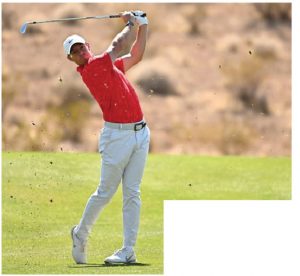
Rory McIl roy –
bi rdie average
When Rory McIlroy’s game is on song, he gives himself so many short range birdie opportunities. The reason for this is his amazing distance control and the secret to this comes from really consistent clubhead speed, coupled with an exceptional ability to strike the ball from the centre of the clubface.
Much like you’d fancy Morikawa to stick a 6-iron as close to the pin as someone hitting a wedge, McIlroy at his best can control his wedges to within a few feet. He strikes down at the same angle, catches the centre of the club and controls the speed beautifully.
If he closes the club a fraction, or leaves it open a touch, the ball will always finish in a slight diagonal so at worst he’ll be looking at ten feet for a birdie, either slightly long left or a little short and right.
To improve this aspect of your game, try working on your posture at set-up, because good posture promotes great balance in the swing and great balance is something that will increase your clubhead speed. You might also want to try placing a tee peg lying on its side directly in front of the ball. Then, try to pinch the ball and tee in front, creating a precise downward strike.


